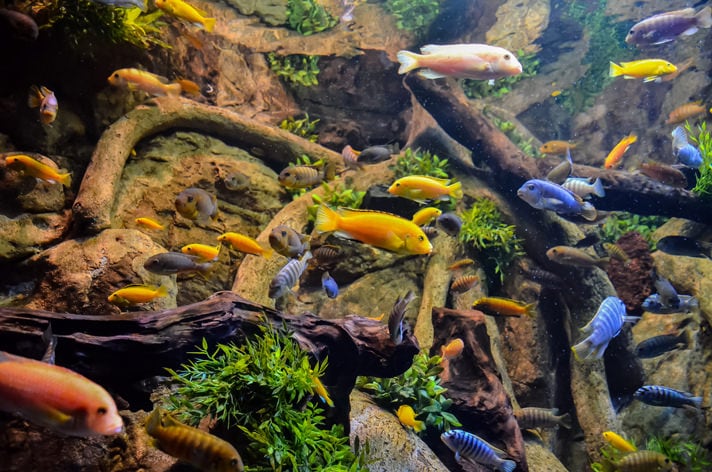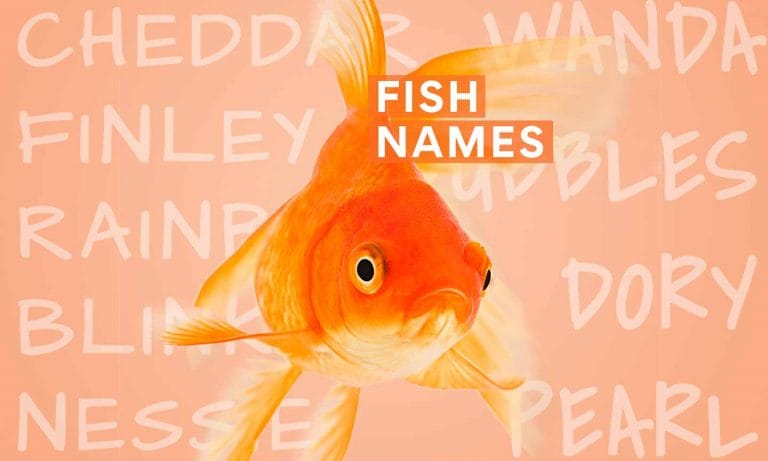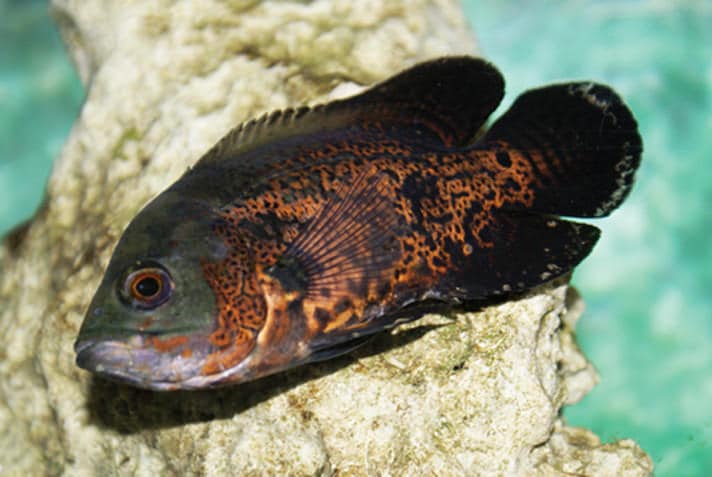The Cichlid family of fishes is large, with many different varieties and sizes. Many of them are very easy to keep, and in this article we will suggest five good ones to start with. They are; Kribensis, convicts, angelfish, oscars, and African Cichlids. We will discuss each individually.
Kribensis
Kribensis (Pelvicachromis pulcher) have been around in the hobby for many years, as they are beautiful and very easy to keep; they have no common name, but are simply called “Kribs.” They are native to Nigeria and Cameroon in Africa, but all of the fish offered at your local fish store will have been commercially bred. Every once in a while a “new variety” will show up, but these are usually just a krib with a little different coloration.
Kribs will do well in virtually any water conditions that other fish are living in. They will thrive on any foods that are being fed to other fish. They are good community tank fish with any fish their own size — until they spawn. And if you have a male krib and a female krib, they will spawn. Kribs pick out a cave-like place (an upside down clay flowerpot, with a notch out of the lip and the hole large enough for the Kribs to go in and out is ideal). The female hides with her spawn in the pot, while the male guards outside.
Typically the first indication that a pair of kribs has spawned is the pair behaving as above with their flowerpot — and all the rest of the fish cowering in the opposite corners, wishing they could get farther away from the insane krib parents.
Kribs will do well in virtually any water conditions that other fish are living in. They will thrive on any foods that are being fed to other fish. They are good community tank fish with any fish their own size — until they spawn. And if you have a male krib and a female krib, they will spawn. Kribs pick out a cave-like place (an upside down clay flowerpot, with a notch out of the lip and the hole large enough for the Kribs to go in and out is ideal). The female hides with her spawn in the pot, while the male guards outside.
Typically the first indication that a pair of kribs has spawned is the pair behaving as above with their flowerpot — and all the rest of the fish cowering in the opposite corners, wishing they could get farther away from the insane krib parents. It takes about a week for the babies to become free swimming, and when they do “mom” leads them around the tank, with any other fish fleeing to as far away as they can. It is not by chance that we started off with Kribs, as they are one of my favorite fish, and definitely the easiest cichlids to keep, and to have spawn in a tank.
Convict Cichlids (Amatitlania nigrofasciata)
The convict cichlid is probably the tale of more woes and destructions than any other commonly kept fish. They are beautiful, active and easy to care for fish, and often are sold by the local fish store as a “community tank” fish. That is well and good — if the community tank consists of other very active, very aggressive and very nasty fishes. Convicts are not always guilty of the bad behaviors above, but they are when they spawn; and they will always be spawning.
Convicts are very easy to keep, as they will adapt to almost any water conditions, pH or hardness, and will eat anything that doesn’t eat them first. The problem, as mentioned above, is when they pair off and spawn. The first signs of a pair beginning to set up house is that they will protect the chosen spawning area — almost always a flat stone, driftwood, or if needs be the bottom of the tank. They spawn out in the open, and drive all of the other fishes in the tank to the corners, where they cower in dread. A pair of convicts with a brood is a sight to behold. Lebanon Aquarium and Pet in Lebanon, NH has one of the best fish rooms I know of. In one of the “trays” (400 gallon tanks about 2 feet deep and about the size of a small grand piano) had a pair of convicts with babies. The other fish in the tank were a large pacu piranha and an even larger iridescent shark. Both of the large fish were in dread of the little pair of convicts. Convicts are very easy to keep — but you need to be careful of what you keep them with.
Angelfish (Pterophyllum scalare)
Angelfish are one of the most beautiful fishes that we keep in tanks, and they are unique. Very high, compressed body, tall dorsal fin and long ventral fin, available in different colors and finnages — angelfish are happy in most water conditions and with most other fish. They will adapt to pH anywhere around neutral (7.0), and moderate hardness. Angelfish have sometimes gotten a reputation for being difficult fish to keep, but this is almost always due to the quality of fish sold at some local fish stores. Look for angelfish that have been in the store for at least a week, that are robust, and are feeding well.
In the aquarium. angelfish should not be kept with fishes that are either bigger and nastier than they are, and also not with smaller thinner fish — like neon tetras. Many a tale of woe is heard from hobbyists who put small (most stores sell angelfish with a body the size of a quarter) angelfish with small tetras; as the fish mature, the angel fish will get to the size where they view their erstwhile tank mates as a snack, and goodbye neons. An interesting aspect of angelfish is that they have been hybridized for many years, and the commercial fish breeders have brought forth a wide variety. The wild angelfish is a silver fish, with broad vertical black stripes. Fish with more stripes and a blackish cast to the body are called “black lace.” Solid black angelfish are sometimes available, though they are rare and not very hardy; many breeders think that the black gene is lethal. Gold and marble angelfish (and gold marble angelfish) are usually available, and new blue angels are coming to market. Also, in addition to the regular fins, angelfish with veiltails are sold, with varying degrees of veils.
Whatever angelfish you keep, they will always do very well once they become established in a tank. Just be careful that no fish in the tank with them is small enough to be eaten by them.
Oscars (Astronotus ocellatus)
Oscars are one of the most recognizable fish in the hobby, perhaps because there are lots of Chinese restaurants and other public places where a single oscar dwells, often as the lone inhabitant of the tank. In addition to their many good qualities we will go into below, the oscar is notable for being one of the few fishes that has kept the scientific name that I remember from years ago.
Oscars now are available in different color forms, the “red oscar” being the most common, and in veiltail varieties, although those are not all that popular — for good reason. A veiltail oscar is a really silly looking fish. Be that as it may, oscars will eat virtually anything, can survive in water conditions that would do in a lesser fish, and look great in their own tank — whether the hobbyist purposely devoted a single large tank to an oscar, or the oscar simply eliminated its tank mates.
By the way, if you have any interest in having oscars breed for you, plan on having a very big (200 gallon plus) tank for them, and having a way to find good homes for up to a thousand baby oscars, as their spawns are huge. Oscars are often fed “feeder” goldfish, an unnecessary expense, as there are many very good dry prepared and frozen fish food that oscars will thrive on. All too often there is a 55 to 125 gallon tank, sitting behind a bar, displaying the owner’s prize oscar — often with a beaten up plecostomus, and sometimes a single goldfish who has become the oscar’s buddy.
African Cichlids
A wide variety of cichlids from the African Rift Lakes (primarily Lake Malawi) are firmly established in the fishkeeping hobby. These are offered by most local fish stores as “Assorted African Cichlids” and often that is exactly what they are — with the emphasis on the word “assorted.” As the various species of cichlids from Africa are very closely related to each other, they will readily spawn with other than their own species. While not to be condoned, these fish are so entrenched in the hobby that they will never go away. And, much as I am a “purist” for my own fish, these assorted African cichlids have gotten many a new hobbyist started off in the hobby.
African cichlids are really tough fish. They require hard and alkaline water, which describes the water conditions that many hobbyists have. A constant temperature is required, but as long as that temperature is between 70 and 80 degrees F these fish will be fine. They will eat absolutely anything, although the fare designed for them is best, supplemented with some fresh greens, and maybe a piece of raw fish every once in a while. Their tank should have lots of rock, driftwood and coral skeletons in it, providing plenty of hiding places. And — unusual to say — they do better when they are crowded. The reason for this is that African cichlids are very territorial, and crowding them together in a tank doesn’t allow any fish to establish a territory. Yes, the fish push each other a bit, and are constantly milling around, but this is preferable to having one fish (or pair) claim half of the tank, and beating up or wiping out all of the other fish.
By: Chewy Editorial
Share:









